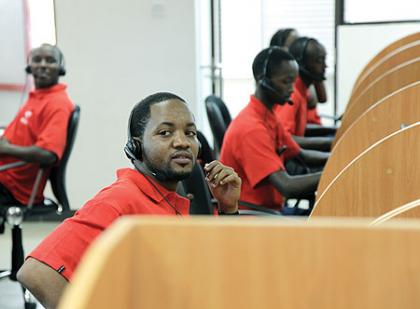With the local telecom market set for battles with the entry of Airtel last week, enthusiasm is high among subscribers as calling and messaging rates continue to go down.


With the local telecom market set for battles with the entry of Airtel last week, enthusiasm is high among subscribers as calling and messaging rates continue to go down. With the latest development, subscribers expect their respective service providers to further cut on their airtime expenses.Airtel has promised world-class and innovative mobile services to Rwandans with its fastest Greenfield launch in the history of sub-Saharan Africa, but the telecom giant has to prove its worth to unravel challenges ahead of it to live up to its expectations.The lower tariff charges strategy which has helped Airtel to claim a significant percentage of subscribers from the regional telecoms, MTN and Safaricom, is yet to be tested in the Rwandan market."We have been hearing that Airtel gives cheap calls. This is why I want to join and see whether this is possible,” Yvette Mukesha, a Kigali resident commented.Experts believe that such perception that has led to a mad rush for the Airtel’s SIM card packages could affect the company’s long term growth as subscribers still envisage the network’s calls to be cheaper."I am buying an Airtel simcard because I want to compare its calling rates to other networks and international calls,” Judith Nalugga, a businesswoman in Kigali told Business Times.With its per minute billing at Rwf20 per minute on-net (airtel to airtel) and Rwf60 off-net (Airtel to other networks), the new entrant has to tighten its belts to overcome MTN’s per-second billing and its off-net tariff of Rwf60 per minute.MTN still boasts of cheapest tariff for all international destinations while Tigo leads the market with cheapest local tariff and promotional tariff on on-net sms with sms at Rwf10 for MTN and Rwf3 for Tigo to Tigo.Airtel’s promotional strategy is to pay back the clients’ money spent on the purchase of their handsets through airtime in six months, and provide cheap recharge cards of up to Rwf100 compared to Tigo’s Rwf300 and MTN’s Rwf500.Indeed, Airtel’s strategy is to comnect Rwanda to the rest of East Africa via its money transfer service come next month. During its launch, the firms coutnrty manager Marcellin Paluku, announced that the move would help to bring more clients on the network, especially the business community.The company has also promised to initially offer 250 jobs, with hopes of raising this to 500 in the next few months, surpassing MTN’s 173, which has the largest employee base in the local telecom sector. But, like in Kenya, Airtel has to brace itself to meet the high interconnection charges from giant MTN and Tigo, who now boast of 2.9m and 1.5m subscribers, respectively.This is likely to eat up its profit margins, a situation that led to the demise of the former third telecom, Rwandatel, after it accumulated over Rwf2billion in interconnection fees to MTN.However, Manoj Kohl, Chief Executive Officer (international l) and joint managing Director Bhart Airtel, insists that the company’s strategy in the country is not to make quick profits but rather, to build a brand that will last for the long term and have a strong relationship with its clients in terms of provision of affordable services to transform their daily lives."What is important is to do credible business and to see our customers grow economically,” he said, adding that the company has made remarkable progress in connecting rural areas with over two million of its subscribers based in rural India.Airtel Rwanda is a subsidiary of Bharti Aitel, one of the top five world’s biggest telecoms with headquarters in New Delhi, India. The firm has a presence in Asia and Africa, giving it over 246 million subscribers, with Rwanda now the company’s 17th presence on the continent.Airtel bought out liquidated Rwandatel, (formerly owned by LAP Green of Libya) network infrastructure, including masts which will give it a chance to extend its network to underserved areas in the country and boost its penetration.Rwanda’s mobile penetration stood at 41.6 per cent, as of December 2011, according to Rwanda Utility and Regulatory Agency (RURA) latest report, with subscriber base at 4.4 million.Judging by its performance elsewhere, Airtel is likely to put up a strong fight. Its strength is also backed by the company’s investment plan of over US $100 million in three years to operate second generation (2G) and third generation (3G) mobile services, as well as fixed line, and a high speed broadband internet connectivity.Kohl added, "We are not here to make a big brand and disappear…We believe that Rwanda is an extremely promising market and this further strengthens our footprint in East Africa.”A Morgan Stanley Research report is optimistic that as capital loaded firms such as Airtel continue to improve their network coverage and decrease tariffs, Africa will become more competitive with new products, data service expansion and market driven innovation.Industry experts are also hopeful that with Airtel’s latest technology platform, network breakdowns currently witnessed in the country will be an issue of the past."This solution is using the latest Eriksson portfolio, and will be the first Airtel network designed as an all-IP solution,” Lars Linden, Eriksson’s sub-Saharan head said, adding that this will enable Airtel to provide advanced services to its subscribers, expand quickly to accommodate quick growth and keep operating expenses down.Recently, MTN faced network failures and call drops with experts relating it to a Central Processing Unit-CPU overload, due to increased subscriber base among others causes. MTN, however, explained that the glitch was due to the Seacom fibre optic cable interruptions.


